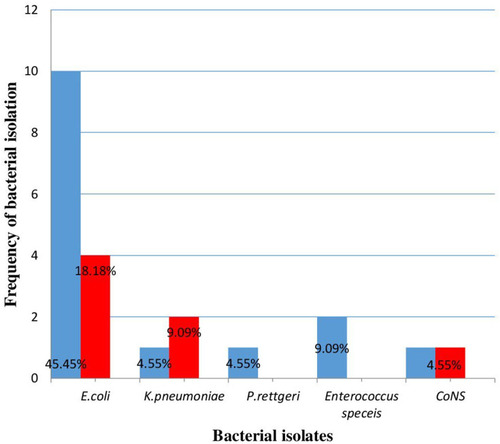Figures & data
Table 1 Socio-Demographic Characteristics of Diabetes Mellitus Patients Investigated for Urinary Tract Infection at Zewditu Memorial Hospital, Addis Ababa, Ethiopia, May to July, 2018
Table 2 Frequency of Symptoms Suggestive of UTI in Diabetes Mellitus Patients in Zewditu Memorial Hospital, Addis Ababa, Ethiopia, May to July, 2018
Table 3 Isolation Rate of UTI in Diabetes Mellitus Patients Investigated for Urinary Tract Infection in Relation to Associated Factors at Zewditu Memorial Hospital, Addis Ababa, Ethiopia, May to July, 2018
Figure 1 Distribution of bacterial uropathogens isolated from symptomatic and asymptomatic urinary tract infections among diabetic patients at Zewditu Memorial Hospital, Addis Ababa, Ethiopia, May to July, 2018. The bar graph shows the frequency of bacterial isolation versus types of bacterial isolates. The vertical axis indicates the frequency of bacterial isolation and the horizontal axis indicates types of bacterial isolate. Blue indicates symptomatic UTIs and red indicates asymptomatic UTIs among diabetes mellitus study subjects. A total of 22 bacteria were isolated, of which 18 were Gram-negative and 4 were Gram-positive. E. coli was the most frequently isolated uropathogen, with a total of 14 isolates; 10 were isolated from symptomatic UTI DM patients and 4 from asymptomatic UTI DM participants. K. pneumoniae was the second most frequently isolated pathogen, accounting for 1 symptomatic UTI DM participant and 2 asymptomatic UTI DM participants. Of the total 22 isolates, 15 were isolated from symptomatic UTI DM participants and the remaining 7 isolates were from asymptomatic UTI DM participants.

Table 4 Antimicrobial Susceptibility Patterns of Gram-Negative Bacteria Isolated from Diabetes Mellitus Patients Investigated for UTI at Zewditu Memorial Hospital, Addis Ababa, Ethiopia, May to July, 2018
Table 5 Antimicrobial Susceptibility Patterns of Gram-Positive Bacteria Isolated from Diabetic Mellitus Patients Investigated for UTI at Zewditu Memorial Hospital, Addis Ababa, Ethiopia, May to July, 2018
Table 6 Multi-Drug Resistance Patterns of Gram-Negative Bacterial Isolates from Midstream Urine Samples Among Diabetes Mellitus Patients at Zewditu Memorial Hospital, Addis Ababa, Ethiopia, May to July, 2018
